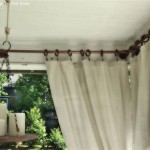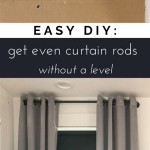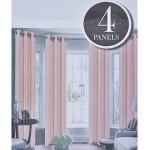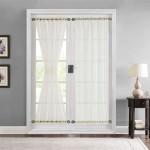Should 84 Inch Curtains Touch The Floor? Exploring Curtain Length Considerations
The question of whether 84-inch curtains should touch the floor is a common one for homeowners and interior decorators alike. The answer, however, is not a simple yes or no. It depends on several factors, including the desired aesthetic, the room's functionality, and the specific window dimensions. Understanding these considerations can help individuals make informed decisions about curtain length to achieve the desired look and feel in their living spaces.
Determining the appropriate curtain length involves a comprehensive assessment of the room's overall design and the function of the window treatment. Unlike standardized clothing sizes, curtain length is subject to various aesthetic preferences and practical requirements. An informed decision regarding curtain length can significantly impact the perceived size of a room, the level of light control, and the overall style of the space.
Understanding Common Curtain Length Options
Before addressing specific window treatment scenarios, it's important to understand the common approaches to curtain length and their respective characteristics. Typically, curtains will fall into one of three general categories: floating, breaking, or pooling. Each of these lengths offers a distinct visual effect and serves different functional purposes.
Floating Curtains: Floating curtains are specifically designed to hang just slightly above the floor, usually by about half an inch to one inch. The intent behind this method is to prevent the curtains from actually touching the floor. This option is often selected for high-traffic areas where dragging fabric could become a nuisance or safety hazard. Floating curtains are also favored in environments that require frequent cleaning, as they don't readily accumulate dust and dirt from the floor. Aesthetically, floating curtains provide a clean, modern look, and they help to make a room feel more spacious, particularly when paired with light-colored fabrics. These curtains are ideal for rooms with baseboard heaters or where pets might be inclined to chew on or damage the fabric.
Breaking Curtains: Breaking curtains are designed to lightly kiss the floor. This means they make contact with the floor, but do not significantly puddle or pool. This style provides a relaxed, casual appearance and is a popular choice for bedrooms and living rooms. The subtle break in the fabric adds a touch of elegance without the drama or potential inconvenience of longer lengths. Breaking curtains offer a balance between functionality and style, allowing for easy movement and minimal obstruction. If a homeowner is unsure about whether to go with floating or pooling curtains, this is often a safe and versatile option.
Pooling Curtains: Pooling curtains are the longest of the three options, extending several inches (typically six to twelve) onto the floor. This creates a luxurious, dramatic effect. Pooling is often seen in more formal settings like dining rooms or master bedrooms. The extra fabric creates soft folds on the floor, adding texture and depth to the room. While visually appealing, pooling curtains require more maintenance, as they tend to gather dust and dirt. They can also be a tripping hazard if not carefully arranged. Furthermore, they may not be suitable for homes with small children or pets who could potentially pull on or damage the fabric.
Factors Influencing the Decision of Curtain Length
Several key elements should be considered when determining the ideal curtain length. These include room function, aesthetic preferences, ceiling height, and practical considerations like maintenance and foot traffic.
Room Function: The intended use of the room heavily influences the appropriate choice of curtain length. In high-traffic areas like hallways or children's playrooms, floating curtains are typically more practical. These prevent tripping hazards and minimize the accumulation of dirt. In formal living rooms or bedrooms where a more opulent and relaxed ambiance is desired, either breaking or pooling curtains may be more suitable. The practicality of cleaning and maintenance in these environments needs to be weighed against the desired aesthetic.
Aesthetic Preferences: Personal style plays a crucial role in determining the ideal curtain length. Modern, minimalist designs often benefit from floating curtains, which maintain a clean and uncluttered look. Traditional, more formal styles often incorporate pooling curtains to create a sense of luxury and grandeur. Breaking curtains, with their subtle touch to the floor, offer a versatile option that can blend well with various décor styles.
Ceiling Height: The height of the ceiling can dramatically impact the effectiveness of different curtain lengths. In rooms with lower ceilings, curtains hung higher than the window frame and allowed to float or break can create the illusion of greater height. Pooling curtains may overwhelm a room with low ceilings, making the space feel cramped. Conversely, in rooms with high ceilings, pooling curtains can enhance the sense of grandeur and fill the vertical space effectively.
Practical Considerations: Maintenance is another factor to consider. Pooling curtains require regular cleaning to prevent dust and dirt from accumulating in the folds on the floor. Floating curtains are generally the easiest to maintain, as they don't come into contact with the floor. Homes with pets or small children may also find floating or breaking curtains more practical, as they are less likely to be damaged or become a hazard.
Applying 84-inch Curtains in Different Scenarios
Now, let's focus on how the 84-inch curtain length works within the various perspectives discussed. The 84-inch length is a common, standardized size that is often found in retail settings, making it a convenient and readily available choice for many homeowners. However, the true functionality of an 84-inch curtain is ultimately dependent on the ceiling height, the placement of the curtain rod, and the desired final effect.
Standard Ceiling Heights (8-9 feet): In rooms with average ceiling heights (approximately 8-9 feet), 84-inch curtains generally work well to achieve either a floating or breaking effect. If the curtain rod is mounted directly above the window frame, the curtains will likely float slightly above the floor. To achieve a breaking effect, the rod would need to be mounted higher, typically several inches above the window frame. This higher mounting also creates the illusion of a taller window and a more spacious room.
Lower Ceiling Heights (Under 8 feet): In rooms with lower ceilings, using 84-inch curtains can be more challenging. To avoid the curtains from dragging excessively, it's often necessary to mount the rod close to the ceiling to maximize the perceived height of the room. Even with a high rod placement, the curtains may still only achieve a floating effect. In some cases, shortening the curtains may be necessary to achieve the desired look.
Higher Ceiling Heights (Over 9 feet): In rooms with high ceilings, 84-inch curtains may appear too short if not properly used. To make them work, consider mounting the rod closer to the window frame, which will result in a floating effect. However, this can sometimes make the window appear smaller. To achieve a more balanced look, consider using longer curtains (96-inch or 108-inch) to cover more of the wall space and create a more dramatic effect.
Ultimately, the decision of whether 84 inch curtains should touch the floor is not a hard fact but a calculated application. The curtain will either be in the floating, breaking, or pooling ranges depending on how the parameters discussed and calculated. By understanding the nuances of curtain lengths, room dynamics, and personal aesthetic preferences, individuals can effectively choose curtains that enhance the beauty and functionality of their homes.

Should Curtains Touch The Floor

Should Curtains Touch The Floor Expert Tips Shade

Track Your Order

Should Curtains Touch The Floor Expert Tips Shade

Should Curtains Touch The Floor Expert Tips Shade

Should Curtains Touch The Floor Expert Tips Shade

Curtain Length Rules For Every Type Of Window

Should Curtains Touch The Floor Expert Tips Shade

The Curtain Conundrum Most Popular Lengths And Where To Use Them Gatheraus

Window Treatment Design Tips Drapes And Shades Custom Designs Fort Lauderdale Fl








